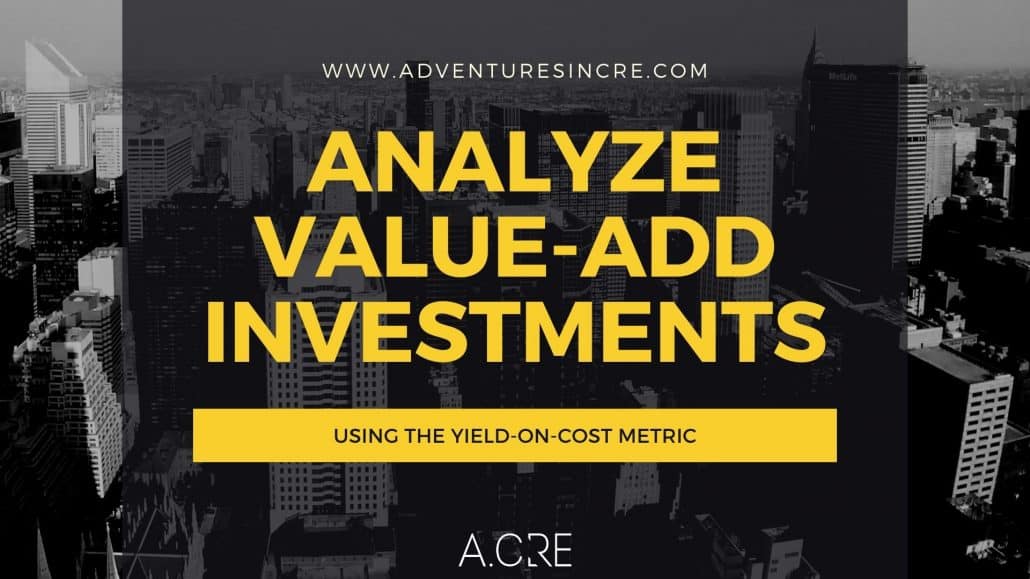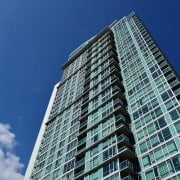Analyzing Value-Add Investments in Real Estate Using Yield-on-Cost (Updated Aug 2024)
So a question recently came in around why a commercial real estate investor would use the Yield-on-Cost metric to assess a value-add real estate investment. This question came on the heals of several other questions also related to development spread (i.e. investment spread) and market cap rate. So I thought I’d put a post together discussing how one can use the Yield-on-Cost metric, together with market cap rate, to assess a value-add opportunity.
Are you an Accelerator member? This article was inspired by a series of forum threads on the topic of underwriting value-add investments in real estate. You can find those threads here, here, here, here, and here. Not yet an Accelerator member? Consider joining the real estate financial modeling training program used by top real estate companies and elite universities to train the next generation of CRE professionals.
What is Yield-on-Cost in Real Estate?
First, the definition of Yield-on-Cost from our A.CRE Glossary of CRE Terms:
“Yield-on-cost is the net operating income (or sometimes cash flow from operations) at stabilization divided by the total project cost.”
In practice, the Yield-on-Cost metric is a comparison tool. It helps the investor evaluate whether the return offered by an investment justifies the risk taken. And since a value-add (or opportunistic) investment has embedded risk that a core investment does not have (e.g. lease-up risk, construction risk, market risk, etc), it’s important to understand the benefit one gets from taking that risk.
In fact, this metric is especially useful for back-of-the-envelope (i.e. quick and effective) analysis. It takes a matter of minutes to calculate the yield-on-cost of a prospective investment, it doesn’t require running a full real estate DCF in Excel, and when compared with a market cap rate, tells you whether that deal is worth spending more time on.
Here’s the logic for calculating Yield-on-Cost:
Risk vs. Return in Real Estate
How does risk play into this discussion? Think of it this way. As an investor you have a basket of investment options available to you. You can take zero risk and buy Government Debt and earn what is called a Risk-Free rate (e.g. 10-yr UST @ 0.69% as of 8.25.2020). You can take a little bit of risk and buy investment grade corporate debt (e.g. US Corporate BBB @ 2.36%).
The more risk one takes, the higher the yield. A private real estate investment is relatively risky, largely because the investment is illiquid and capital intensive. And thus, a real estate investment commands a greater yield (e.g. U.S CBD Office cap rate @ 6.65%) than say investment grade corporate debt.
Market Cap Rate and Its Place
Now in real estate, risk varies by property, market, investment type, etc. The higher the risk, the higher the expected return. Cap Rate acts as the baseline. It’s effectively the yield, before growth, of what you’d earn on a fully stabilized (e.g. core) investment.
Sure, cap rates differ by property type, class, and market, but otherwise with all else being equal, the cap rate should be the same between two comparable stabilized properties.
Yield-on-Cost, Cap Rate, and Investment Spread
Yield-on-cost thus becomes the metric that helps you assess how much value (i.e. additional yield) you’re earning for taking risk on unstabilized investments.
In the case of a value-add investment, the additional risk you’re taking is the bet that spending money to improve the building will earn you higher rents, or that your operating company can reduce costs thus increasing NOI, or that you will be able to re-lease an empty building, etc.
In other words, you’re betting that you can improve the value of the building by taking some steps beyond just maintaining the existing state of the asset.
This bet is risk. And that risk deserves some premium. Thus, to calculate the premium you first calculate the Yield-on-Cost.
You then compare that Yield-on-Cost to the market cap rate of a stabilized but otherwise comparable property and ask, is the premium worth the risk? That premium is sometimes referred to as the Investment Spread (or Development Spread). And if the premium is high enough, the risk is worth taking.

Yield-on-Cost – Market Cap Rate = Investment Spread (i.e The Yield-on-Cost Premium Over Market Cap Rate)
An Example of Using Yield-on-Cost to Assess a Value-Add Deal
I’m getting long-winded, but bare with me! I want to make sure this is well-understood, as this concept is the key to back-of-the-envelope financial analysis in value-add and opportunistic strategies.
Imagine you have an opportunity to buy an empty office building for 1,000,000. You build a stabilized pro forma (i.e. calculate NOI for when the building is fully leased) and estimate that net operating income will be 100,000 upon stabilization. Furthermore, you calculate that you’ll spend 100,000 in leasing costs and 25,000 in carry costs to get you to stabilization.
You thus calculate Yield-on-Cost by taking the stabilized net operating income (100,000) and dividing it by the total project cost (1,000,000 + 100,000 + 25,000 = 1,125,000). You get a YOC of 8.89%.
100,000 ÷ 1,125,000 = 8.89% YOC
You research the market and find that fully stabilized office buildings, similar to yours in your market, are trading for a 7.00% cap rate. Thus, the spread you earn for taking the risk on this value-add opportunity is 8.89% – 7.00% = 1.89%.
YOC (8.89%) – Market Cap Rate (7.00%) = Investment Spread (1.89% or 189 bps)
And with that data you ask yourself, is it worth the risk to earn 189 bps more on the value-add deal? If the answer is no, you’re better off buying a stabilized property at a 7.00% cap rate. If the answer is yes, then you continue to pursue the value-add opportunity.
Conclusion on Using Yield-on-Cost to Assess Value-Add Investments
Yield-on-Cost is a powerful, yet relatively simple, metric to assess value-add opportunities. In fact, if you talk to the old guys in real estate they’ll tell you this is how deals were underwritten before computers. IRR, Equity Multiple, DCF; those are relatively new concepts to real estate underwriting.
But Yield-on-Cost effectively tells you much of the same thing with far less processing power!
For those looking to deepen their understanding and enhance their analytical skills, consider exploring our new Data Analysis GPT for Commercial Real Estate. This tool uses AI technology to help streamline your complex data analysis tasks. Whether it’s enhancing your hold-sell analyses like we discussed in this article or tackling other data-intensive tasks in CRE, the Data Analysis GPT can provide powerful support.
Frequently Asked Questions about Using Yield-on-Cost to Assess Value-Add Real Estate Investments
What is Yield-on-Cost in commercial real estate?
Yield-on-Cost is defined as “the net operating income (or sometimes cash flow from operations) at stabilization divided by the total project cost.” It helps investors evaluate whether the return justifies the risk in a value-add or development deal.
Why is Yield-on-Cost useful for value-add investments?
Yield-on-Cost is quick to calculate and useful for back-of-the-envelope analysis. It tells investors what yield they’ll earn on cost at stabilization, helping them judge whether a deal is worth pursuing before running a full financial model.
How do you calculate Yield-on-Cost?
Divide the stabilized net operating income (NOI) by the total project cost. For example, if stabilized NOI is $100,000 and total cost is $1,125,000, Yield-on-Cost = 100,000 ÷ 1,125,000 = 8.89%.
What is the relationship between Yield-on-Cost and Market Cap Rate?
Yield-on-Cost should exceed the market cap rate to justify the added risk of a value-add investment. The difference between the two is called the Investment Spread or Development Spread.
What is Investment Spread and why does it matter?
Investment Spread is calculated as Yield-on-Cost minus Market Cap Rate. It represents the premium an investor earns for taking on value-add risk. A higher spread indicates better compensation for that risk.
Can you provide an example of Yield-on-Cost analysis?
Yes. If you buy a building for $1M, spend $125K on lease-up and carry, and project stabilized NOI of $100K, your YOC is 8.89%. If similar stabilized properties have a 7.00% cap rate, your spread is 1.89%. You must then assess if that premium is worth the risk.
Is Yield-on-Cost better than IRR or DCF for analysis?
Yield-on-Cost isn’t necessarily better—it’s faster and simpler. It’s ideal for initial screening, while IRR and DCF are more comprehensive tools used later in the underwriting process.
Where can I learn more or practice using this metric?
Consider using A.CRE’s Data Analysis GPT and exploring their real estate case studies and financial models. These resources help build proficiency in metrics like Yield-on-Cost and support real-world underwriting practice.









